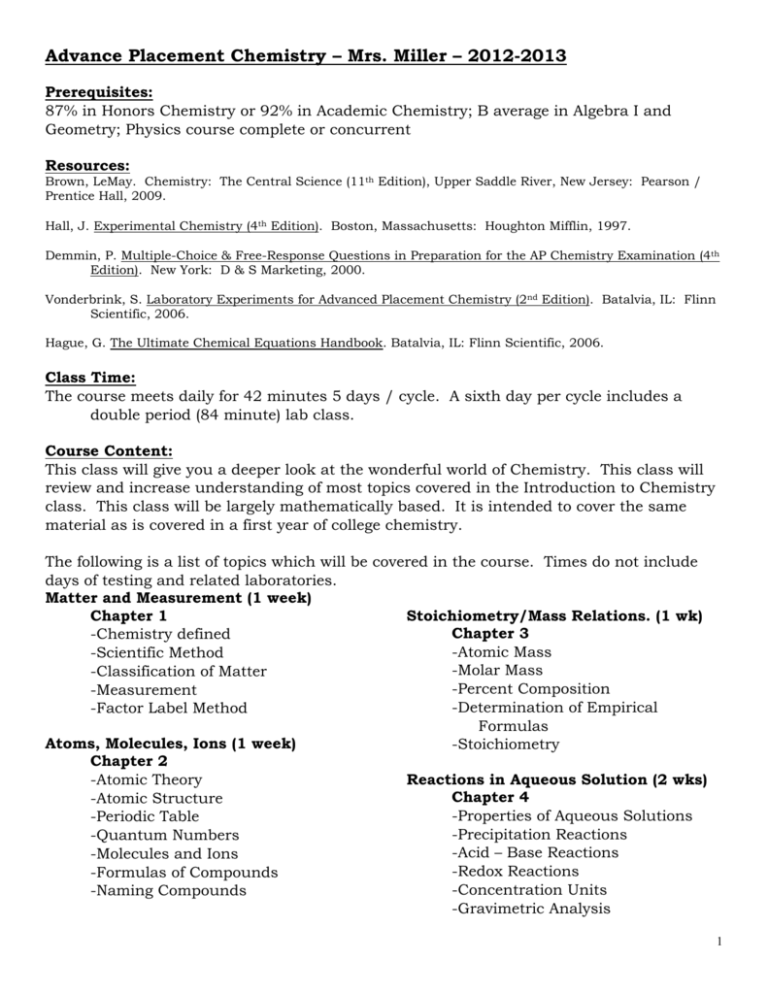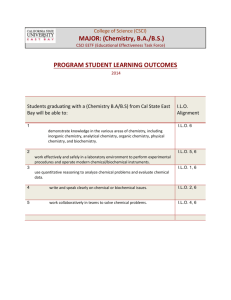
Advance Placement Chemistry – Mrs. Miller – 2012-2013
Prerequisites:
87% in Honors Chemistry or 92% in Academic Chemistry; B average in Algebra I and
Geometry; Physics course complete or concurrent
Resources:
Brown, LeMay. Chemistry: The Central Science (11th Edition), Upper Saddle River, New Jersey: Pearson /
Prentice Hall, 2009.
Hall, J. Experimental Chemistry (4th Edition). Boston, Massachusetts: Houghton Mifflin, 1997.
Demmin, P. Multiple-Choice & Free-Response Questions in Preparation for the AP Chemistry Examination (4th
Edition). New York: D & S Marketing, 2000.
Vonderbrink, S. Laboratory Experiments for Advanced Placement Chemistry (2nd Edition). Batalvia, IL: Flinn
Scientific, 2006.
Hague, G. The Ultimate Chemical Equations Handbook. Batalvia, IL: Flinn Scientific, 2006.
Class Time:
The course meets daily for 42 minutes 5 days / cycle. A sixth day per cycle includes a
double period (84 minute) lab class.
Course Content:
This class will give you a deeper look at the wonderful world of Chemistry. This class will
review and increase understanding of most topics covered in the Introduction to Chemistry
class. This class will be largely mathematically based. It is intended to cover the same
material as is covered in a first year of college chemistry.
The following is a list of topics which will be covered in the course. Times do not include
days of testing and related laboratories.
Matter and Measurement (1 week)
Chapter 1
Stoichiometry/Mass Relations. (1 wk)
Chapter 3
-Chemistry defined
-Atomic Mass
-Scientific Method
-Molar Mass
-Classification of Matter
-Percent Composition
-Measurement
-Determination of Empirical
-Factor Label Method
Formulas
Atoms, Molecules, Ions (1 week)
-Stoichiometry
Chapter 2
-Atomic Theory
Reactions in Aqueous Solution (2 wks)
Chapter 4
-Atomic Structure
-Properties of Aqueous Solutions
-Periodic Table
-Precipitation Reactions
-Quantum Numbers
-Acid – Base Reactions
-Molecules and Ions
-Redox Reactions
-Formulas of Compounds
-Concentration Units
-Naming Compounds
-Gravimetric Analysis
1
AP Chemistry
-Titrations
-Writing Reactions for the AP Exam
Thermochemistry (2 weeks)
Chapter 5
-Enthalpy
-Calorimetry
-Heat of Solution and Dilution
Structure of Atoms (1 ½ weeks)
Chapter 6
-Basics of Quantum Theory
-Bohr Model
-Overview of Quantum Mechanics
-Quantum Numbers
-Atomic Orbitals
-Electron Configurations
Periodic Relationships (1 week)
Chapter 7
-Classification of Elements
-Periodic Variation
-Physical Properties: Effective
Nuclear Charge; Atomic Radius; Ionic
Radius; Ionization Energy; Electron
Affinity
-Chemical Properties: General
Reactivity; Ability to React with Various
Reactants and Products of those Reactions
Chemical Bonding (2 ½ weeks)
Chapter 8 and 9
-Lewis Dot Symbols
-Ionic Bonds
-Lattice Energy
-Covalent Bonds
-Lewis Structures
-Resonance and Formal Charge
-Bond Dissociation Energy
-Molecular Geometry
-Valence Bond Theory
-Hybridization
-Overview of MO Theory
Gas Laws (2 weeks)
Chapter 10
-Properties of Gases
-Gas Laws
-Ideal Gas Equation
-Stoichiometry
-Kinetic Molecular Theory
Intermolecular Forces, Liquids and
Solids (1 week)
Chapter 11
-Kinetic Molecular Theory
-Intermolecular Forces
-Properties of Solids and Liquids
-Phase Changes
-Phase Diagrams
Properties of Solutions (1 week)
Chapter 13
-Temperature and Pressure Effects
-Colligative Properties
-Types of Solutions and Mixtures
Kinetics (1 ½ weeks)
Chapter 14
-Rate of a Reaction
-Rate Law
-Activation Energy and Catalysts
-Reaction Mechanisms
Equilibrium (1 ½ weeks)
Chapter 15
-Equilibrium Constant
-Equilibrium Expressions
-Le Chatlier’s Principle
Acids/Bases and Solubility and More
Equilibrium(3 weeks)
Chapter 16 and 17
-Definitions of Acids and Bases
-pH
-Acid / Base Strength
-Ionization Constants
-ICE Method
-Common Ion Effect
-Buffers
-Titrations
-Indicators
-Solubility Rules
-Solubility Equilibrium
2
AP Chemistry
Chemical Thermodynamics (1 week)
Chapter 19
-Laws of Thermodynamics
-Entropy
-Spontaneity
-Free Energy
Electrochemistry (1 week)
Chapter 20
-Redox Reactions
-Balancing Redox Reactions
-Electrochemical Cells
Organic Chemistry (2 days)
Chapter 25
-Basic Nomenclature
Nuclear Chemistry (2 days)
Chapter 21
-Nature of Nuclear Reactions
Coordination Compounds (1 day)
Chapter 24
Laboratory Content:
Laboratories will typically be performed on the double-laboratory period included within
our six-day cycle. The laboratories are hands-on and performed in groups of 2-3 students
depending on class size. A major goal of AP Chemistry is for you to learn good laboratory
techniques. Some experiments have been conducted during your Introductory Chemistry
Course and will only be reviewed this year.
The following is a list of laboratory experiments to be performed:
-Determination of a Chemical Formula (Magnesium oxide) – Completed in Introductory
Chemistry
-Percent of Water in a Hydrate (Copper (II) sulfate pentahydrate) – Completed in
Introductory Chemistry
-Molar Mass by Vapor Density (Acetone, etc.) - (2 Periods)
-Molar Mass by Freezing Point Depression (Lauric Acid and Benzoic Acid) – Completed in
Introductory Chemistry - (2 Periods if time allows)
-Molar Volume of a Gas (Butane) – Completed in Introductory Chemistry
-Acid / Base Chemistry
-Titration with Primary Standard - (2 Periods)
-Titration with a Weak Acid – (2 Periods)
-Selecting the Correct Indicator – (2 Periods)
-Buffer Chemistry (Creating a buffer, Calculating pKa) – (4 Periods)
-Titration Using a pH Meter – (2 Periods if time allows)
-Redox Titration – (2 Periods)
-Stoichiometric Relationships (Sodium bicarbonate plus Hydrochloric Acid, Single Metal
Displacement Reaction, etc) – Completed in Introductory Chemistry
-Determination of Equilibrium Constant – (4 Periods)
-Determination of Rate of a Reaction – (3 Periods)
-Calorimetry – (2 Periods)
3
AP Chemistry
-Qualitative Analysis – Completed in Introductory Chemistry
-Gravimetric Analysis (Precipitation of Silver chloride) – (4 Periods)
-Colorimetry (Beer’s Law Plot of Copper (II) sulfate solutions) – (2 Periods)
-Chromatography – Basic Chromatography Completed in Introductory Chemistry – ThinLayer Chromatography (2 Periods)
-Electochemistry – (2 Periods)
-Synthesis of a Coordination Compound (If Time Allows)
-Synthesis of an Organic Compound (If Time Allows)
Student Time Requirements:
Keeping up with assigned work and reading over your notes regularly (not just the night
before the test) will be an important way to do well in this class. The AP Course Description
Booklet (which is published by The College Board) assumes each student will spend AT
LEAST 5 hours per week in unsupervised individual study. If there is a topic that you
find difficult, come in for tutoring! Don’t be afraid to ask questions!!
Grading:
-Specific assignment points will be on difficulty and amount of time allotted for the
assignment. Listed point values are approximate.
Grades for each quarter will include:
-Tests are typically given after each chapter, but may include multiple chapters based on
material covered. Questions primarily come from old Advanced Placement Chemistry
Exams. (20 – 50 points each).
-Chapter Homework (5 – 20 points each). These will come from each chapter of the Chang
Chemistry book. There are two benefits to doing the homework – the points and the
practice for the tests. You will be permitted two excused scores on homework per quarter.
-Lab Reports will be either formal or informal write-ups (15 – 30 points each). The format
is as follows:
Introduction: A description in your own words explaining why the experiment was
performed. Include any chemical reactions and equations that will be used.
Experimental: A BRIEF overview of what was done in the laboratory. It should
include the names of any equipment used. Lot numbers of chemicals should
also be included. This section should be written in past tense and passive
voice.
Results: A summary of what was found. Include data tables, etc. Answer any
questions posed in the lab.
Conclusion: A final sentence or two stating why or why not the results are
reasonable.
4
AP Chemistry
Not all sections will be required for each lab report. A “formal” report will include all
sections. I will outline the requirements for each lab report before the laboratory is
completed. Reports must be typed or written in blue or black ink.
In class recording must be done in ink, on duplicate paper, always include your
name, the date, title of experiment, and all procedures and observations. Do not
erase or scribble out - Make one solid line through any mistakes and include a brief
explanation of the error.
-Projects will be assigned quarterly (20 –30 points each). Options include: A
demonstration, Article Summary/Critique, Research Paper, Laboratory Assistant,
Preparation of an Introductory Chemistry Lesson
-Lab Participation and Lab Attitude (10 – 20 points)
Absence:
Students are responsible to make up work due to absence. It is the responsibility of the
student to obtain any missed work.
Students should get any notes missed from a fellow student. I will be happy to go over
those notes upon request.
Arrangements must be made with the teacher to make up laboratory work.
Late work will have points deducted for each day late. The number of points per day will be
decided by the teacher for each assignment.
5








